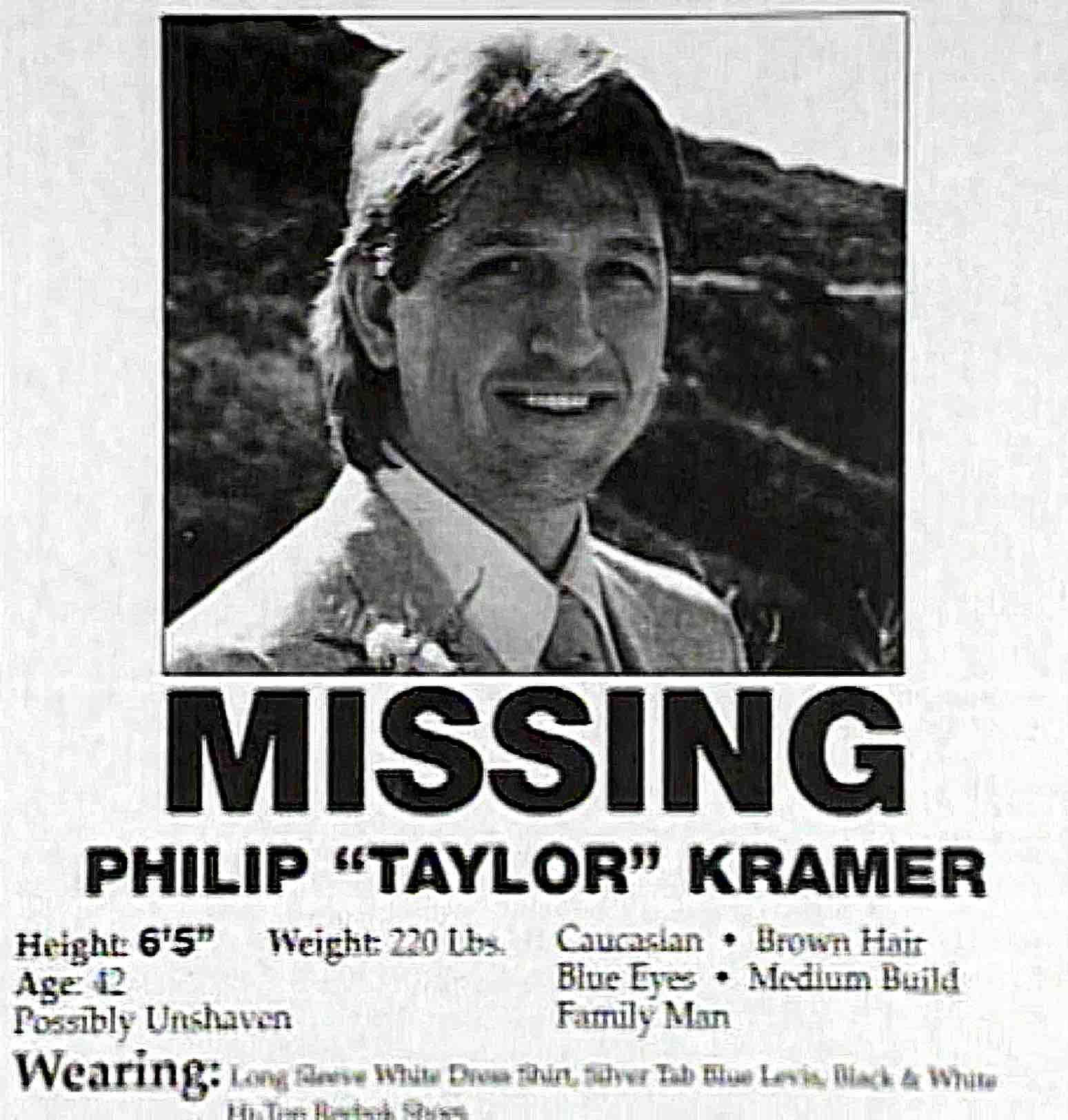Dig into the story of Philip Taylor Kramer, and you’ll find you are left with far more questions than answers about what led to the untimely demise of this once-promising physicist, rockstar, and tech mogul.
While Kramer clearly lived his truncated life to the fullest, his 1995 disappearance and later reported suicide has left many wondering what really happened. At the time Kramer initially disappeared, he claimed to have been working on technology he said would enable a computer to spot a missing child amidst thousands of people, and all by showing the technology just a portion of the child’s face.
In hindsight, it certainly sounds like Kramer was working on a kind of image recognition technology that approaches the machine intelligence in use today. Taking his mysterious and secretive behavior into account, many have also theorized that some individual or agency had been pursuing him because of this potentially groundbreaking work. But was this really the case?
Born on July 12, 1952, in Youngstown Ohio, Kramer’s early life was one filled with curiosity and learning. While there isn’t much public information about Kramer’s early years, we know that his father, Ray, was a local professor of electrical engineering. Throughout Kramer’s life, his father was obsessed with trying to disprove Einstein’s theories—mainly the concept that objects cannot travel faster than the speed of light—a quest that Philip would eventually also inherit. While Kramer was only a child, he enjoyed learning about his father’s research and eventually became interested in science. At age 12, he won a school science fair by building a laser strong enough to pop a balloon.
Though Kramer had the curiosity and passion for learning, he chose not to pursue a college career. Instead, in 1974, he joined the psychedelic rock band Iron Butterfly as its bass guitarist, recording two albums with the band, Scorching Beauty and Sun and Steel, both released in 1975.
It was at the height of his music career that Kramer also seems to have undergone a sort of personal crisis. He began urging people to stop calling him “Philip” and instead call him only “Taylor.” After only a year with the Iron Butterfly, Kramer decided it was time to change careers and announced he would be leaving the band, although he continued to play with Ron Bushy, a founding member of the group, in later years.
From Music to Missiles
Following his departure from Iron Butterfly, Kramer eventually attended college and received his aerospace engineering degree from the Western States College of Engineering. From there, he went to work on the MX missile guidance system as a subcontractor for the Department of Defense, a position that would have granted Kramer access to sensitive information the likes of which some believe could have affected his later life.
“Glen Mavis worked with Kramer at Northrop, and both had to swear a national security oath,” a 1996 Washington Postarticle stated. Mavis would claim to have noticed Kramer’s office cubicle taped shut on several occasions, something engineers did “to signal that their work was classified and not to be viewed by anyone else.”
“Mavis isn’t sure exactly what Kramer was doing,” the Post reported, “but he knows it involved helping to get the MX missile to fly accurately.”
Following his work for the DoD, Kramer moved on to more user-based technology. Though his degree focused on aerospace engineering, he was interested in video compression, and in the early 1990s worked on fractal compression and facial recognition systems within the burgeoning tech industry of the period. While such systems are commonplace today, this wasn’t so much the case in the 1990s, at which time Kramer became recognized as one of the field’s leading experts.
Kramer used this expertise to his advantage when he founded Total Multimedia in 1990 with Randy Jackson, the brother of Michael Jackson. The company focused on data compression for digital storage and claimed they were the first to create a video compression method for a full motion video produced on a single-speed CD-ROM; the claim has never been substantiated, although if true, it would have underscored Kramer’s worth to the media industry of the time.
Despite this, maintaining a multimedia company proved to be harder than Kramer and Jackson anticipated. In 1994, Total Multimedia filed for bankruptcy, a development which had a noticeable impact on Kramer. Although he continued to consult for similar companies, and eventually went on to create SoftVideo, a software based on fractal compression, financial problems were plaguing Kramer, and he now owed tens of thousands of dollars to friends and family.
Many who knew Kramer, including former coworker Glen Mavis, had said he “frequently operated on the financial margins,” accruing debts in a number of business ventures, from which he always seemed to have rebounded.
“He could deal with it,” recalled Mark Spiwak, another of Kramer’s former business partners, who remembered Kramer always resurfacing after facing such problems.
While this may have been Kramer’s outward appearance, behind the scenes the former rock star turned technology entrepreneur was doing his best to cope with such situations by burying himself in work. Eventually, Kramer also stumbled onto the work of James Redfield, as outlined in his bestselling book, The Celestine Prophecy, which Kramer is known to have read (devoured might be a better description), employing the wisdom he gleaned from it to raise his vibration and purportedly communicate with non-human intelligences.
However, it was also during this tumultuous period that Kramer supposedly began to be involved with other more cutting-edge technology, something he kept secret from his friends and associates. Some have even aired the opinion that he was working on technology that would have allowed immediate data-transfers, a breakthrough that Kramer believed would discredit Einstein’s faster-than-light theories.
According to his wife, Jennifer, Kramer had told her that this new technology had “been there the whole time” and “it was so simple, that no one had found it before.” Kramer reportedly explained to his spouse that the technology could use facial recognition to find lost children or missing individuals, possibly by employing machine intelligence to perform these tasks. Naturally, this would have made the technology more advanced than any systems in use at that time, and also more dangerous if it fell into the wrong hands. Kramer’s dedication to his new work led to sleep deprivation resulting from days of unceasing work, eventually giving rise to paranoia. Later, both his father and his wife would recall that Kramer began to voice concerns that people were coming after him because of the technology he was developing. Although there remains no proof that this was anything more than paranoia beginning to manifest in the now visibly exhausted Kramer, his disappearance did cause many to wonder whether such fears might have been justified.
The Disappearance
On February 12, 1995, Kramer left for Los Angeles International Airport, where he was scheduled to pick up his wife and a business associate. However, Kramer never arrived.
Calling his wife instead to let her know his plans had suddenly changed, over the phone, Kramer mentioned he had a surprise for her later, and told her he loved her very much. This was only one of the many calls to friends and family that Kramer would make over the course of the next twenty minutes.
Former bandmate Ron Bushy received a similar call. “Bush, it’s Taylor,” he remembered Kramer saying. “I love you more than life itself,” he said before hanging up.
After Kramer made the rounds by phone, he then called 911. According to the transcript, he told the operator he planned to kill himself, adding, “I want everyone to know O. J. Simpson is innocent,” an apparent reference to Kramer being asked to give expert testimony on the video footage of the murders at the Simpson trial underway at that time.
“They did it,” an obviously paranoid Kramer added. It was the last thing anyone would ever hear him say.


Kramer’s disappearance attracted almost immediate attention. A segment about him aired on the Oprah Winfrey Show and on America’s Most Wanted, as Kramer’s family worked to obtain any information they could about their missing loved one. Standing at 6’5” and weighing 220 pounds, Kramer made for a memorable figure and would have been hard to miss. While many people did come forward claiming to have seen him after his disappearance, no leads were produced that helped provide any clues as to his whereabouts.
The Discovery of Philip Taylor Kramer
It wasn’t until May 1999 that two photographers finally discovered Kramer’s green van, which had apparently crashed at the bottom of Decker Canyon, 1.5 miles east of the Pacific Coast Highway. According to dental records, the remains found within the van were confirmed to belong to Kramer. Although his estimated value was in the millions, a total of just 40 cents was found in his pocket—not even enough to afford the airport parking he would have had to pay for, had he kept with his original plans the day he disappeared.
Though Kramer had now been found, questions still needed to be answered: mainly, how he and his car ended up at the bottom of the canyon.
“Somebody put a gun to his head,” suggested Ron Bushy, who in addition to remaining a musical collaborator had also been Kramer’s closest friend at the time of his death. As Bushy explained to the Washington Post, he believed Kramer had been killed “because he’d just made a breakthrough in this new technology.”
Both local police and the FBI investigated Kramer’s death. Some did in fact wonder if foul play was involved: was Kramer driven off the road to prevent national secrets from leaking? Had his murder been to stop any more information about the Simpson case from being released?
Based on the coroner’s report, it seemed that Kramer died only a short time after he disappeared. Conspiracy theories that ranged from a government cover-up to time traveling soon began to surface as possible scenarios that might have led to Kramer’s death; claims the majority of which are either impossible, or at least have no way of being verified. While Kramer’s family denies that he would have killed himself given the chance, suicide seems the most probable answer today, and the one police gravitated toward at the time, as the likeliest means by which he drove his car off the cliff into the canyon.
“We’ve got no motive,” said private investigator Chuck Carter, a former police officer and DEA agent hired by Kramer’s business partners to investigate the case. Kramer’s fragile mental state, as well as his lack of sleep in the weeks leading up to his disappearance, all pointed to the likelihood of suicide, although some loose ends remained.
We will probably never know the full story behind the demise of Philip Taylor Kramer, although it remains a bizarre cold case that continues to puzzle and fascinate us. While the likelihood of new evidence seems remote, perhaps new information about the case will indeed surface, allowing Kramer’s friends and family to receive the closure they have long hoped for.

